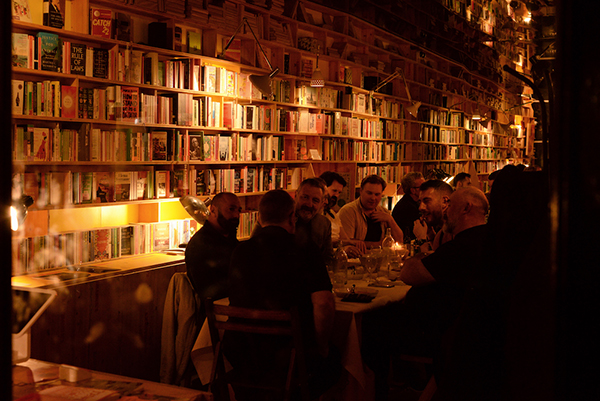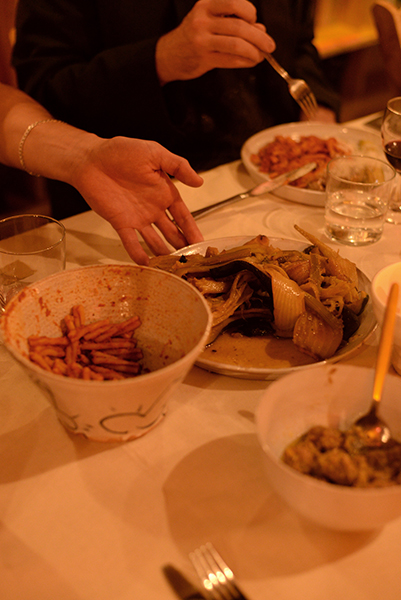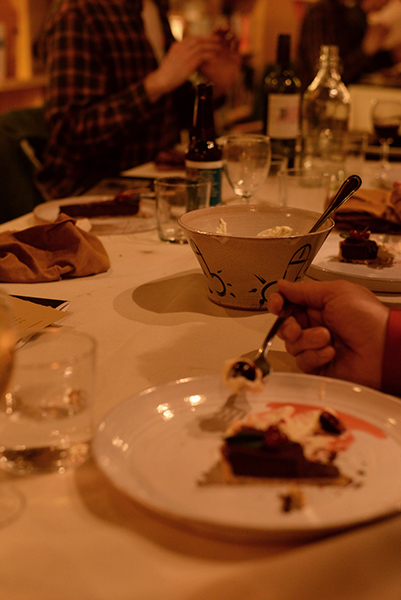On a quiet side street just off the bustle of Brick Lane, in a quirky little bookshop called Libreria, a table is set for dinner. At first glance there is nothing unusual about this supper club: candles flickering in the low light; a long linen-clothed table; lines of folding chairs. Yet look a bit closer and it might not seem quite as normal as you thought. At each setting is a photo book of candid portraits from the 90s documenting young gay men in their homes. The books are complemented by plates painted with plump juicy peaches and bowls drawn with cocks. The supper club is GAZE, a rare introspective insight into the non-normativity of queer homemaking.

Hosted by curator Davy Pittoors, and catered by artist Will Martin, GAZE is a celebration of photographer Marc Vallée’s book 90s Archive: Volume One, which launched at The Photographer’s Gallery in 2022. What makes this photo series unusual is its intimate illumination of queerness as a domestic practice. Archival imagery of queer 90s London usually centres on clubs and bars, rarely on the familiarity of home. Indeed, society has historically eschewed notions of queerness from the home, and queers have reciprocated by closing their doors on society’s unforgiving gaze. GAZE explores this tension by opening its doors in an outward display of queer domesticity.
To gain a better understanding of their perceptions of domesticity, I speak to Davy and Will before the event. For Davy, domesticity is about curating spaces in which he feels safe, a practice which manifests itself in aestheticism. For Will, by contrast, the domestic is aspirational; it is something he might never achieve, and thus becomes about moulding spaces to better suit him. He uses the rental housing market as a relatable analogy to queer homemaking: in a space that isn’t yours you are a temporary feature; you don’t wholly belong yet you make it your own.
This notion is echoed by the queer historian Stephen Vider. In The Queerness of Home he suggests the domestic is mutable, defined by its inhabitants yet nonetheless societally influenced. He likens domesticity to a script: “socially determined yet individually enacted; predetermined yet open to interpretation, improvisation, revision, and failure.” Queer domesticity is thus a subtle practice in alterity. Both Will and Davy agree that domesticity helps them create their space in the world, both introspectively and practically. For them, it is a quiet way to rebel against the norm, a curatorial and culinary queering of convention.
It is apt, then, that a supper club is how Davy and Will choose to celebrate Marc Vallée’s book. Supper clubs negate the normativity of eating out through ‘social dining’, a philosophy of using meals to connect socially. In contrast to restaurant dining, which promotes exclusivity and individuality, supper club guests are seated next to strangers at communal tables, coming together to enjoy the same dishes. At GAZE, Will serves crostini piled high on communal boards; sharing bowls covered in dicks and filled with casarecce alla marinara and sausage ragù; thin slices of rich tarte au chocolat with macerated berries. Each of his dishes inspires informality and is designed to encourage the communality of social dining.

Social dining is recognised by philosophers such as Jean Soler and William Robertson Smith for its power to break social barriers and engender companionship between strangers. Indeed, the very word ‘companion’—from the Latin com, ‘together with’, and panis, ‘bread’—is ‘one with whom you break bread.’ The democracy that arises from social dining has been celebrated throughout history. From the Classical tradition of shared feasting to France’s post-Revolutionary communal dinners to celebrate ‘fraternity,’ shared food makes for the most savoured meals.
The sharing of a meal with a stranger also elicits a social contract between host and guest. Both can expect mutual respect: the former in return for their hospitality and the latter through their invitation. From Will’s perspective, as a queer man, this is doubly important. Welcoming a stranger into your space takes implicit trust after a lifetime of social exclusion. This equality pervades every aspect of GAZE. In spite of this event being a talk, Davy has gone to lengths to ensure that everyone is seated equally, and his discussion with Marc is open to evolve at any time into a wider conversation. As the evening plays out, the event begins to feel like a raucous family dinner as everyone relaxes and their stories flow forth.

A traditional family dinner, whether nightly or weekly, riotous or pious is synonymous with domestic life. Bread is broken across generations, and the experience of age can facilitate an exchange of wisdom with the awareness of youth. However, for many queers, mealtimes can be places of misunderstanding, whether benign or malign, and the wisdom we receive is often misguided.
Through GAZE, Will and Davy reformulate the traditional family dinner by bringing together a ‘chosen family,’ and facilitate a lesser seen side of queer homemaking: an intergenerational queer meal. Queer youths don’t often have an experienced elder to turn to for wisdom. Indeed, many who might have shared their wisdom fell victim to the AIDS epidemic. Those who did not succumb suffered its societal impacts and were swept aside, their wisdom deemed perverse.
Since he shot 90s Archive: Volume One, Vallée’s work took a more photojournalistic route. Revisiting his archives has thus been cathartic for him, enabling him to introspect his own practice. During the talk, Marc is asked whether he will reshoot his models now. He responds that he has been trying to shoot a new generation of young queers in their homes, hoping to diversify his initial young white male cast. However, without the trust of friendship in his original shots, Marc has struggled to find willing subjects — a poignant reminder that even within the community, the queer domestic remains a safeguarded space.
GAZE’s queer domestic introspection will take on new levels as they set their sights on The Museum of the Home for one of their upcoming events. They will be working with the museum to inject more queer narratives, stories and perspectives throughout the exhibits. Through their supper clubs, Davy and Will invite everyone to take a seat at the table with their non-normative chosen family. Their events offer us a unique insight into what domesticity is to them, and might just inspire us to question our own perceptions of it, too.

Barney Pau is an artist, chef, and writer, whose practice focuses on food futures, foraging, queering consumption, and the history of agriculture. When he’s not baking bent bread, peering at plants on the pavement, or painting erotic landscapes, you can usually find him foraging for his food or reading books on bread.

NOTCHES: (re)marks on the history of sexuality is licensed under a Creative Commons Attribution-NonCommercial-NoDerivatives 4.0 International License.
Based on a work at www.notchesblog.com.
For permission to publish any NOTCHES post in whole or in part please contact the editors at NotchesBlog@gmail.com




